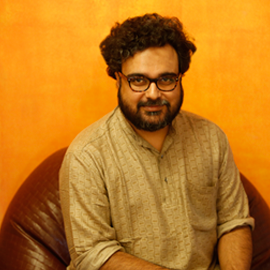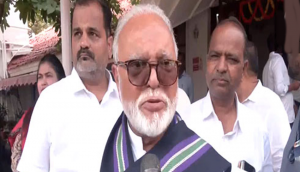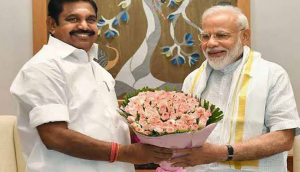Bihar polls: Seat distribution confirms that BJP is the only boss in NDA

The distribution
- The NDA announced its distribution of seats for the Bihar polls on Monday
- Here\'s the division: BJP 160, LJP 40, RLSP 23, HAM 20
- BJP will contest 2/3rds of Bihar\'s 243 seats
- The party hopes to come close to a majority on its own
The hitches
- The allies are unhappy with the number of seats they have been given
- LJP wanted 70 seats. Jitan Ram Manjhi\'s HAM wanted to be equal to LJP
- But each one of them claim to have compromised for the larger good
- The real challenge would be allocating specific seats
- Each party wants to contest the maximum number of safe seats
The NDA's seat-sharing formula in Bihar has made it clear that the BJP calls the shots in the alliance.
The distribution of seats was announced at the Bharatiya Janata Party (BJP) headquarters in Delhi on Monday. 15 leaders from all the 4 NDA constituents were present at the press conference but only one person spoke: BJP president Amit Shah. The others watched like mute spectators.
Predictably, the BJP will be contesting the lion's share of the seats:160 out of 243, which is almost 2/3rd. RamVilas Paswan's Lok Janshakti Party (LJP) has been given 40 seats. Upendra Kushwaha's Rashtriya Lok Samata Party (RLSP) will contest 23 seats and the remaining 20 seats have been given to the Hindustani Awam Morcha (Secular) of former Bihar chief minister Jitan Ram Manjhi.
Since the Grand Alliance of the Janata Dal (United), Rashtriya Janata Dal and Congress had announced their seat-sharing formula a while back, there was constant pressure on the NDA to do the same.
Apparently, the BJP had made its desire to contest 2/3rd of the seats amply clear to its allies. So the real question was dividing the remaining seats among the three smaller parties.
The real question for the NDA isn't the number of seats but figuring out which party is to contest from which seat.
Here's an assessment of what the seat-sharing formula means for each of the parties.
BJP
The saffron party hopes to get close to the majority mark of 122 on its own might. This would provide stability to its government and reduce its dependence on its allies. Though the party has made it clear that it will not ditch its allies even if it gets a majority on its own.
In the 2010 Assembly elections, the BJP had contested 102 seats and won 91, with a vote share of 16.46% . In the 2014 Lok Sabha elections, the party won 22 seats. The NDA got 31 seats out of 40.
LJP
Ram Vilas Paswan's original demand was for over 70 seats. But now he would have to remain content with 40. Even though this still makes LJP the largest party after the BJP, party workers aren't happy as they wanted the party to contest at least 50 seats.
"Paswan ji is the most prominent face of the NDA in the state. He has a bigger base and a better understanding of politics. We agreed to this arrangement for the larger good of the alliance," says a senior LJP leader.
Probably what went against the party is its poor performance in the last Assembly elections. In 2010, LJP contested 75 seats and won only 3. Its vote share was 6.75%.
The challenge isn't the number of seats but figuring out which party is to contest from which seat
"Paswan has a committed 4.5% vote base. He knows how to transfer his votes. His is the only Dalit community which can counter the Yadavs' muscle on the ground," explains a political analyst from the state.
"He (Paswan) will now concentrate on getting the seats of his choice. He compromised on numbers. There will be no compromise on seats," says a LJP leader.
RLSP
Upendra Kushwaha's RLSP has been given 23 seats. In 2013, Kushwaha, parted ways with his old friend Nitish Kumar and took away much of his Kushwaha OBC base.
This is the first Assembly election for the RLSP. In the 2014 Lok Sabha elections, the party contested three seats and won all three.
Besides Kushwahas, the party has some support among Bhumihars as well. This gives RLSP a broader acceptability. The party kept demanding more seats and Kushwaha was even projected as the most eligible CM candidate. They would be disappointed with the allocation of 23 seats.
Hindustani Awam Morcha (Secular)
Jitan Ram Manjhi is the NDA's Mahadalit face. His exit from the JD(U) has been one of the biggest blows for Nitish.
As there is an element of rivalry between Manjhi and Paswan, the sentiment in HAM was that the party should be allotted as many seats as the LJP. However, it ended up with half.
"Manjhi has more votes than LJP. He has more MLAs as well. He is a bigger Dalit leader than others in the NDA. Yet we have got less seats. This is our sacrifice for the larger good," says a party insider.
HAM's rank and file were particularly confident of getting a respectable number of seats because of the manner in which Prime Minister Narendra Modi promoted Manjhi in his rallies.
However, the BJP president declared that some candidates from HAM would contest under the BJP's symbol. The number of such candidates could be around 5.
First published: 15 September 2015, 12:16 IST







![BJP's Kapil Mishra recreates Shankar Mahadevan’s ‘Breathless’ song to highlight Delhi pollution [WATCH] BJP's Kapil Mishra recreates Shankar Mahadevan’s ‘Breathless’ song to highlight Delhi pollution [WATCH]](https://images.catchnews.com/upload/2022/11/03/kapil-mishra_240884_300x172.png)

![Anupam Kher shares pictures of his toned body on 67th birthday [MUST SEE] Anupam Kher shares pictures of his toned body on 67th birthday [MUST SEE]](https://images.catchnews.com/upload/2022/03/07/Anupam_kher_231145_300x172.jpg)






